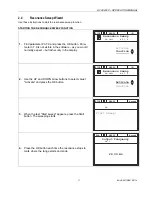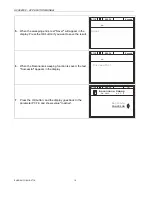
HVAC400X – APPLICATION MANUAL
3
EN2B-0417GE51 R0719
Fig. 1. Parameter table
Legend
A.
The location of the parameter in the menu, that is, the parameter number.
B.
The name of the parameter.
C.
The minimum value of the parameter.
D.
The maximum value of the parameter.
E.
The unit of the value of the parameter. The unit appears if it is available.
F.
The value that was set in the factory.
G.
The ID number of the parameter.
H.
A short description of the values of the parameter and/or its function.
NOTE:
You can download the English and French product manuals with applicable safety, warning and caution
information from
http://hwll.co/inverter
.
Functions of the HVAC400 Drive
• Wizards for startup, PID control, pump and fan cascade control, and fire mode to make commissioning easy.
• The Loc Rem button for an easy change between the local and the remote control place. The remote control
place can be I/O or fieldbus. Using a parameter, you can select the remote control place.
• Run interlock input (Damper interlock). Drive does not start before this input is activated.
• A control page to operate and monitor of the most important values quickly.
• Different pre-heat modes to prevent condensation problems.
• A maximum output frequency of 320 Hz.
• A real-time clock and timer functions (an optional battery is necessary). It is possible to program three time
channels and five intervals to get different functions on the drive.
• Two PID controllers are available. You can use them, e.g., to control a valve with the I/O of the HVAC drive.
• A sleep mode function that automatically enables and disables the operation of the drive to save energy.
• A 2-zone PID controller with two different feedback signals: minimum and maximum control.
• Two setpoint sources for the PID control. This is selected using a digital input.
• A function for PID setpoint boost.
• A feedforward function to make the response to the process changes better.
• A process value supervision.
• A pump / fan cascade control is available to control up to five motors.
• A pressure loss compensation to compensate pressure losses in the pipework, e.g., when the sensor is
incorrectly placed near the pump or fan.
• Single input control where the analog signal (0-10V or 4-20 mA) can also be used to start and stop the motor
without additional inputs.
A
B
F
C D
E
G
H
Index
Min Max
ID
Unit
Default
Description
Parameter




































